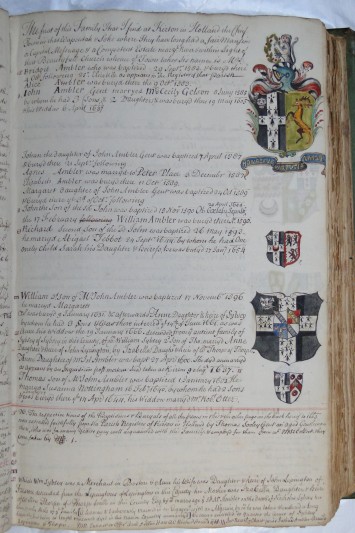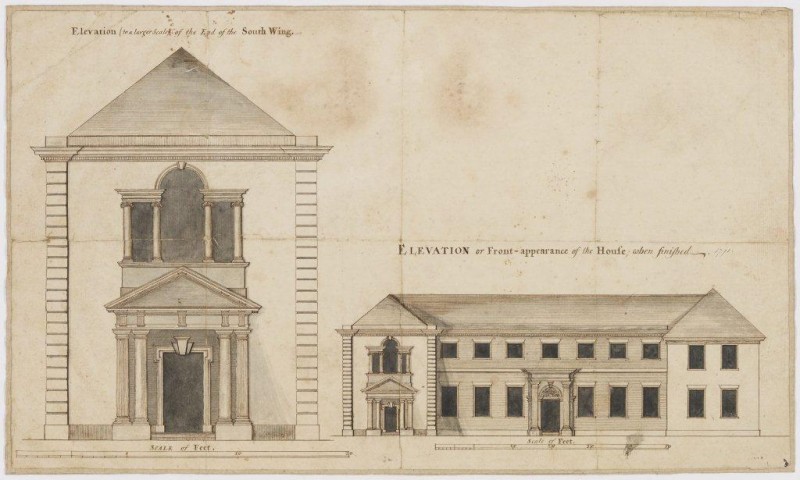This poll-book, which was owned by Maurice Johnson (founder of the Society) illustrates a most interesting episode in England’s history and further illumates the friendship between Johnson and William Stukeley, Vicar of All Saints’ in Stamford. The 1734 general election took place in the wake of a crisis in Sir Robert Walpole’s administration. Stamford was a pocket borough under the control of the Earls of Exeter of nearby Burghley House. The poll book, listing voters and the way they voted, was printed after the election, in answer to the cries of corruption from the defeated Whigs, to show that the Tory candidates had won the election fairly.
Search FNL grants since 1931
Maurice Johnson’s 'Armes & Memoires of ffamilies in Lincolnshire’ is an exceptional example of early eighteenth-century antiquarian practice. The manuscript volume bears a bookplate dated 1735, but was probably begun by Johnson c. 1720 and continued by him at least until 1747. It contains genealogical and historical materials relating to the families in his wide circle of antiquarian, professional and social acquaintance. Johnson was founder of the Society.
The Coker Court manuscripts consist of the family and estate archives of the Helyar family of East Coker, in south Somerset, and of the Walker, Heneage and Button families of Somerset, Wiltshire and Gloucestershire. The collection extends to 4.6 cubic metres and is an outstanding example of a family archive, containing materials dating from the Middle Ages to the 20th century. The collection is significant not only for the study of Somerset and the West Country, but also for the light it throws on aspects of national and international history.
This letter was written by Walter Adolphus Dunne, a Sub-Assistant Commissary attached to the 24th Regiment. Dunne was one of the defenders of Rorke’s Drift, and wrote the letter only hours after the battle finished in the early hours of 24 January 1879. It is a vivid document and must be the earliest account of the defence.
Michael Faraday is best known for his scientific work and teaching undertaken at the Royal Institution from 1812 until his death in 1867. Comparatively little is known about his personal life and religious beliefs, and a large part of what is known lies within this correspondence with his nieces.The Milton collection of correspondence was the largest collection of Faraday letters still to remain in private hands. Most of the 31 letters are concerned with matters relating to the Sandemanian church, of which Faraday and most of his relations were members.
Thomas Pitt was amongst the most important of the amateur English Architects of the 18th and 19th centuries. This group of seven drawings largely relates to this period and includes the designs for remodelling Boconnoc's entrance (east) front, which survives, and extending the south front.
The archive of the actress Billie Whitelaw relates to her work with Irish writer and Nobel Prize winner Samuel Beckett. Billie Whitelaw was Beckett's favourite actress. The items join the rest of the University's Beckett Collection, which is the world's largest collection of manuscript materials relating to Beckett.
These are two of the first books printed in Scotland which are, together, of great significance for the history of printing in Scotland and for the evidence they contain about the wider cultural context and history of Scotland at this time. The Aberdeen Breviary, printed in 1509-1510, is the book for which printing was introduced to Scotland. No-one knows what happened to printing in Scotland between the end of Chepman’s work on the Aberdeen Breviary in 1510 and the first surviving printing by Thomas Davidson, which cannot be earlier than 1532. The Compassio is the only witness to the fact that there was still printing in Scotland during these years. The acquisition was made possible thanks to a substantial additional grant awarded by the B H Breslauer Foundation.
The first edition of Humphrey Repton’s An enquiry into the changes of taste in landscape gardening of 1806: Repton was one of the great landscape gardeners of the 18th century, and is often considered the successor to Capability Brown. His commercial success was often attributed to the 'red books' he created for clients, which demonstrated his before and after plans. This book is a follow up to Repton's Observations on the Theory and Practice and looks at historical landscape gardening as well as aesthetic details. In 2013, MERL acquired the library and archives of the Landscape Institute, and has a new focus on garden and landscape design: Repton's book offers an important insight into early developments
The Letters Patent granted the 'Establishment of a Board Society or Body Corporate for the Encouragement of Agriculture’, is dated 23 August 1793.

